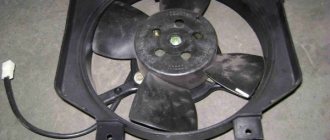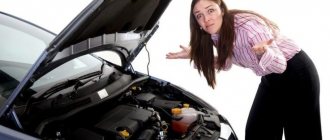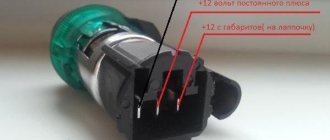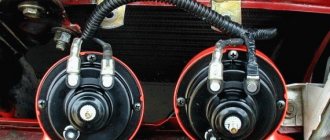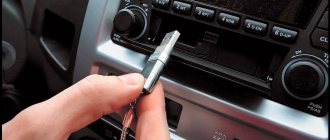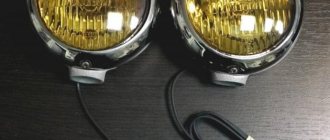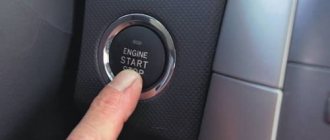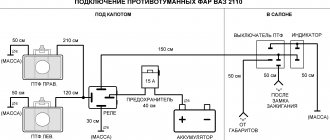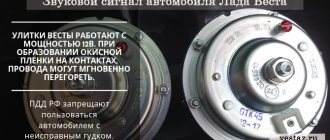1200 rub. for the photo report
We pay for photo reports on car repairs. Earnings from 10,000 rubles/month.
Write:
The starter solenoid relay is an electromagnet that performs two functions in the ignition system. The first is to bring the Bendix starter gear to the flywheel ring gear. The second is its return to its original position after starting the engine. A breakdown of the solenoid relay may result in the engine simply not starting . There are not many reasons for relay failure. In this material we will try to describe the signs and causes of failure, as well as diagnostic and repair methods.
Solenoid relay with core
Operating principle of the solenoid relay
Before moving directly to the malfunctions and methods for eliminating them, it will be useful for car owners to know the device of the starter retractor relay and how it works. It is immediately worth noting that the mechanism is a classic electromagnet , consisting of two windings (holding and retracting), a circuit for connecting it to the starter, as well as a core with a return spring.
When the ignition key is turned, voltage from the battery is supplied to the coils of the solenoid relay. This creates an electromagnetic field that moves the core located in its body. That, in turn, compresses the return spring. As a result of this, the opposite end of the “fork” moves towards the flywheel. In this case, the gear connected to the bendix is squeezed out until it engages with the flywheel ring. As a result of engagement, the contacts of the built-in starter circuit are closed. Next, the retracting winding is turned off, and the core remains in a fixed position with the help of a working holding winding.
Scheme of operation of the solenoid relay
After the ignition key turns off the engine, voltage to the solenoid relay stops supplying. The anchor returns to its original position. The fork and bendix, which are mechanically connected to it, disengage with the flywheel. Thus, a malfunction of the starter solenoid relay is a critical failure due to which it is impossible to start the engine.
Recommendations
- It is important to ensure that contacts other than the control terminal and spade contact are not short-circuited or accidentally connected.
- Taking into account the fact that access to the starter is usually from below, you need to be prepared for the need to remove standard or additional protection
- On many cars, the control terminal has the form of a threaded outlet (a nut is screwed onto a bolt), while the terminal is of the “petal” type.
We also recommend reading the article about what to do if the alarm blocks the engine from starting. From this article you will learn how to remove the engine blocking alarm if a failure or error occurs.If there is such a possibility, it is better to close the contacts not with a screwdriver, but with a wrench that has a handle (the handle should be well wrapped with insulation).
- After completing the process of starting the engine, you should check the fuses separately, as they can burn out if mistakes are made;
- Considering that the traction voltage uses 30-50A and higher, the connection points may stick.
- Owners of old cars, where the switch does not control the voltage supply to the coil, need to remember that when the starter closes, the coil may fail;
Starter solenoid relay diagram
Solenoid relay circuit
In addition to the previous point, we present to your attention a diagram of the starter retractor relay . With its help, it will be easier for you to understand the principle of operation of the device.
The solenoid coil of the relay is always connected to the negative side through the starter. And the holding winding goes directly to the battery. When the relay core presses the working plate against the bolts, and “plus” is supplied to the starter from the battery, then a similar “plus” is supplied to the “minus” output of the retractor winding. Because of this, it turns off, and the current continues to flow only through the holding winding . It is weaker than the retractor, but has sufficient strength to constantly hold the core inside the housing, which ensures continuous operation of the motor. The use of two windings allows you to significantly save battery energy when starting the engine.
ELECTRICAL DIAGRAM OF ENGINE STARTING AND CHARGING SYSTEMS FOR DAEWOO MATIZ
Lada Priora Sedan Logbook Preparing for winter. Starter
Power is supplied to the elements of this electrical circuit from the battery (1), through the ignition switch (2) to pins 2 and 5 from connector 102, having previously passed through fuses E15 and E16 with a rating of 30 Amps. From pin 3 of the ignition switch, through connector C202, power is supplied to the starter (4) and the starter relay (3) (Bendix). From pin 4, through fuses F10 and F14, 10 and 15 A, respectively, a charging control circuit with an indicator (5) passes through. Through connectors C101, C102 and C 202, the circuit is connected to contacts 1 and 2 of the generator voltage regulator (6). From the B+ contact of the generator, the charging current through the B+ contact on the starter travels through one wire to the positive terminal of the battery. Connections to the ground of the electrical circuit elements are marked: G104, G105 and B. For more details on the markings and color scheme of the circuit, see the designations and description “how to” read wiring diagrams for Daewoo Matiz.” To download the diagram, click on it with the left mouse button, and then, when it is highlighted, enlarge it and by clicking the right button, select “save as...”.
Wiring diagram for connecting the battery, starter and generator on Daewoo Matiz
| CONNECTOR NO. (CONTACT NO. AND COLOR) | CONNECTING HARNESS | CONNECTOR POSITION |
| C101 (pin 32, black) | Engine - fuse box in engine compartment | Fuse box in the engine compartment |
| C102 (pin 32, gray) | Instrument panel - engine compartment fuse box | Fuse box in the engine compartment |
| S202 (pin 23, white) | Engine - dashboard | Driver's left footwell |
| G104 | Accumulator battery | Under the battery |
| G105 | Accumulator battery | Near the starter |
Location of contact numbers and symbols:
Wiring of connectors of the ignition switch, starter and generator Daewoo Matiz 2005 onwards.
Location of connectors: 1 generator connector 2 ignition switch connector 3 starter (Bendix) relay connector 4 involved connectors in the dashboard
Drawings explaining the location of detachable connections in the engine compartment.
Daewoo Matiz_location of connectors and ground connections Fig. 1
Daewoo Matiz _location of connectors and ground connections Fig. 2
Finding the connectors under the panel:
How to check the solenoid relay
There are several methods for checking the solenoid relay. Let's look at them in order:
- The operation of the relay can be determined quite simply - at the moment of startup, a click is heard produced by the moving core. This fact indicates the serviceability of the device. If there is no click, it means that the starter retractor relay does not operate. If the retractor clicks but does not turn the starter, then the likely reason for this is that the relay contacts are burnt.
- If the solenoid relay is activated, but a peculiar rattling noise is heard, then this indicates a malfunction in one or both relay windings . In this case, the starter solenoid relay can be checked using an ohmmeter by measuring the resistance of its windings. It is necessary to remove the core and return spring from the housing, and then check the resistance between the windings and ground in pairs. This value should be within 1.3 ohms. After this, insert the core without a spring, close the power contacts and measure the resistance between them. This value should be 3.5 ohms (the value depends on the specific relay). If the measured value is lower than the indicated numbers, then we can talk about a short circuit in the circuit and failure of the windings.
Repair of starter retractor relay
Worn relay contact plates
On many modern cars, the solenoid relay is made in a non-separable form. This is done for two reasons. First, this increases the reliability of the mechanism and its durability due to mechanical protection from external factors. The second is that automakers want to make more profit from the sale of their components. If your car has just such a relay, then the best solution in this case is to replace it. Write down the brand of the relay, its technical parameters, or better yet, take it with you and go to the nearest store or car market for a similar new one.
However, some car owners repair it themselves. But at the same time you need to know how to disassemble the starter solenoid relay . If the relay is collapsible, then it can be repaired. In the case of non-dismountable parts, repairs are also possible, but to a small extent. In particular, when burning “nickels”, improving and cleaning the contact. If one of the windings burns out or short-circuits, then such relays, as a rule, cannot be repaired.
Series-wound electric motors
A load is connected to the motor shaft (what it must turn). If you check how the motor torque will change as the load accelerates, it turns out that at first it is the largest, and gradually decreases.
Mechanical characteristics of an electric motor with sequential excitation.
From the characteristics it is clear that while the engine is not moving (zero speed), the torque is maximum.
This is the most suitable property for starting heavy loads. The moment should be maximum precisely when the load has not yet moved. Further, as it accelerates, the moment of resistance decreases, so the torque of the electric motor is able to maintain the rotation of the load. Such properties are suitable for many cases where it is necessary to move, for example, an electric train, a lifting mechanism, etc.
Starting the rotation of an internal combustion engine is also a difficult process. Engine parts have an impressive mass, and in addition, the engine immediately begins to compress air in parts of the cylinders, so it is very difficult to turn it over. Thus, a series-wound motor must be used for the starter. It has the most torque while it's still moving.
Scheme of a starter motor with sequential excitation
The field windings are arranged around the armature with a minimum gap to create a strong magnetic field. The excitation current and the armature current are the same current, it first passes through one excitation winding, then through the second, then through the positive brushes connected by a jumper, passes through the armature to the negative brushes.
Another option, also sequential excitation, only the excitation current branches into two branches.
Another diagram showing the polarity of magnetization
The series-wound motor has a dangerous disadvantage
If you unwind it and release it (remove the load), it will begin to easily unwind further, the speed will increase so much that the conductors will be pulled out of the rotor by centrifugal force, this is a sad end, the starter will jam and it will have to be scrapped.
Briefly it can be written as follows: an electric motor with series excitation is prone to runaway.
Types of solenoid relays and their manufacturers
Let's briefly touch on the solenoid relays used on VAZ cars. They are divided into four types:
- for non-geared starters of VAZ 2101-2107 (“Classic” models);
- for non-geared starters of VAZ 2108-21099 models;
- for VAZ gear starters of all models;
- for AZD starter gearboxes (used in VAZ 2108-21099, 2113-2115 models).
In addition, as mentioned above, they are divided into collapsible and non-collapsible. Older models are collapsible. New and old are interchangeable .
For VAZ cars, solenoid relays are produced by the following companies:
- Plant named after A.O. Tarasov (ZiT), Samara, Russian Federation. Relays and starters are produced under the KATEK and KZATE trademarks.
- BATE. Borisov Automotive and Tractor Electrical Equipment Plant (Borisov, Belarus).
- Kedr Company (Chelyabinsk, Russian Federation);
- Dynamo AD, Bulgaria;
- “Iskra” A Belarusian-Slovenian enterprise whose production facilities are located in the city of Grodno (Belarus).
When choosing a particular manufacturer, it is necessary to take into account that the highest quality and most common brands are “KATEK” and “KZATE”. Also remember that if an AZD starter is installed on your car, then “native” relays manufactured at the same enterprise are suitable for them. That is, they are not compatible .
Results
The starter retractor relay is a simple device. However, its failure is critical , as it will not allow the engine to start. Even an inexperienced car owner with basic plumbing skills can check and repair the relay. The main thing is to have the appropriate tools at hand. If the relay is not removable, we still advise you to replace it, since, according to statistics, after repairs are completed, its service life will be short. Therefore, if the solenoid relay does not work in your car, buy a similar device and replace it.
Hi all! I haven’t written anything in the logbook for a long time. And there were no breakdowns. But a week ago I drove up to the store and turned off the car. And after 10 minutes, when turning the ignition key, the car showed no signs of life. A minute of confusion, and I try again, again zero. I went through all the possible breakdowns in my head. I opened the hood, closed the two retractor bolts with a screwdriver, the result was zero. I immediately realized that the starter had come to an end. I had to push it to start it. I drove it into the garage. I removed the starter. I started to unscrew the nut from the 2nd retractor bolt, from which the + goes to the starter. And either the thread is Chinese or I’m a handyman :). As a result, the nut came off with a piece of the stud.
Solenoid relay replacement process
Solenoid relay RDS 2110.
If the starter does not operate when the ignition is turned on or only works every once in a while, then most likely the reason lies in the solenoid relay.
replace it without removing it from the vehicle , but as practice shows, it is best to remove it.
Required Tools
This is what a retractor looks like. You will need a tool.
To make a full replacement you will need some tools.
Namely: a flat screwdriver, a ratchet and a socket 8. Attention: if the car enthusiast is not sure that he will be able to carry out repair and restoration work on his own, then it is recommended to contact a car service center.
Algorithm
Let's consider the sequence of actions aimed at changing the solenoid relay on a VAZ-2110:
- First of all, you will need to turn off the power to the vehicle so as not to short-circuit the network and not burn anything.
- We remove the starter from the car.
- Remove the terminal from the starter and move it to the side.
We unscrew the housing where the solenoid relay is located.
We take out the solenoid relay.
The relay is pulled from the starter.
Electric motor with mixed excitation
A motor with parallel excitation will cope much worse with the start of rotation, but on the other hand, it is not afraid of runaway. A compromise solution is that a mixed excitation circuit is used for the starter motor - the main winding is series and the auxiliary winding is parallel. The parallel winding also helps to turn the electric motor; it also prevents the starter from spinning out.
In this circuit, the current from the battery is branched, part of the current goes through the left field winding and sequentially goes through the brushes to the armature. The other part of the current goes through the right, parallel excitation winding, immediately to minus.
Most of the later starter circuits with electromagnetic excitation are made exactly according to this scheme.
Source
Selecting a part for a VAZ-2110
Often the entire starter assembly is replaced, but we recommend not doing this. The pull-out relay is much cheaper than the entire kit.
The choice of a new relay should be approached with the utmost seriousness, since the quality of the part will determine how long it will serve the owner.
Most VAZ-2110 are equipped with a solenoid relay manufactured by Bosch, with catalog number 2339303293 . The cost of the part is about 2000 rubles.
Analogs
In addition to the proposed version of the original part, there are quite a lot of analogues that can be installed on a car. So, many car enthusiasts do just that. Let's look at what the automotive spare parts market offers the owner of a 2110:
- Cargo 131143 – the cost is 1200 rubles. High quality for little money.

